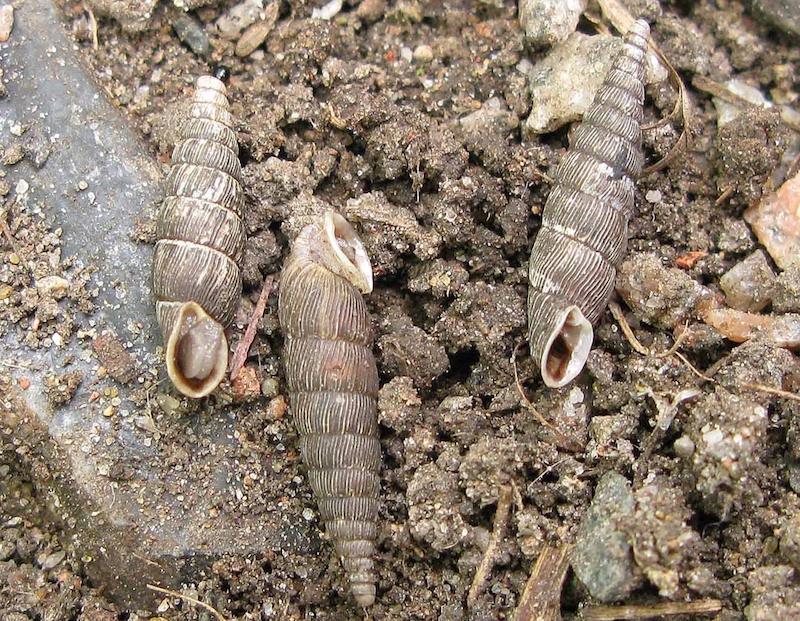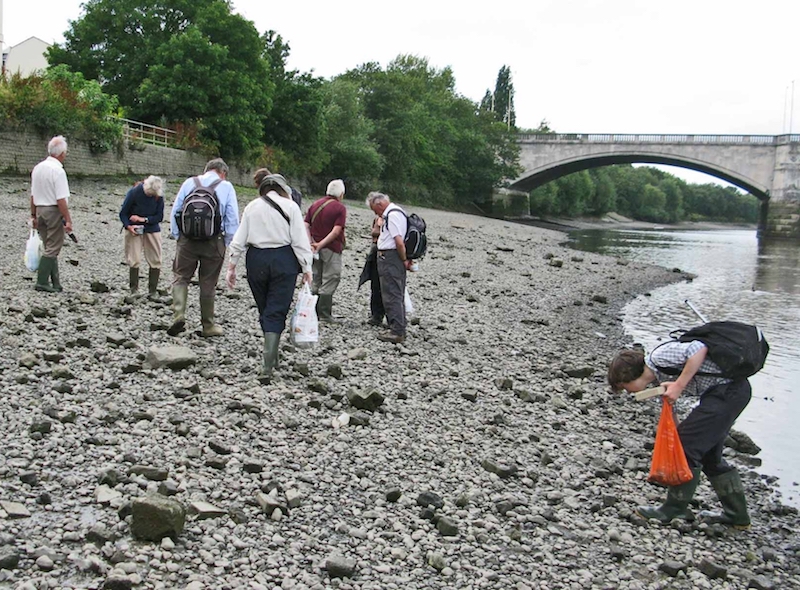|
Ten Conchological Society members assembled at Kew Gardens Railway Station at midday. Those who arrived early had time to study the handout and acquaint themselves with the programme for the day.
The main purpose of the meeting was to examine two known sites for the rare and local British snail Balea biplicata. This species is common on the continent and is believed to have been accidentally introduced into Britain in about Roman times. The species was originally described from Easton Grey, Wiltshire by Montagu in 1803, a locality where it has not been re-found. It is also known from Hyde Park, Cambridge, Somerset, and various localities next to the River Thames in the London area. Sadly, the species no longer occurs at most of these due to development work over the years. The Kew area is fortunate in that there are four sites where it still occurs. The two that were not visited during this trip were in vegetated ground next to the River Thames at Chiswick just downstream of Barnes Railway Bridge (map reference TQ 213764) (see Boycott, 1929) and amongst nettles on Isleworth Ait (TQ167758).
The first of the sites visited was Occupation Road, Kew (TQ195773), only a short walk from the station. The site consists of a rather untidy nettle patch with common Cow Parsley (Anthriscus sylvestris) and Mugwort (Artemisia vulgaris) on either side of a footpath leading to the River Thames towpath. The site was discovered over 40 years ago when living specimens were abundant. They were most obvious after rain when they could be found crawling beyond the edges of the patch. They are not as common here now because the footpath has been widened several times to allow lorries access to the towpath for defence works and this has damaged the habitat. Careful searching by members revealed empty shells but no living animals. The Public Records Office grounds are on the south side of the path where a triangular area of lightly wooded nettle patch is managed as a protected area for the species. Permission to visit this part of the site wasn't sought on this occasion. After spending some time in Occupation Road the party searched the area on the north-east of the reserve, next to the towpath. Many live specimens were found here. The mollusc fauna of this area is much reduced from what it used to be. Nine other species were found. The only one of any note were a few shells of Hygromia cinctella. This species spread to the Kew area about ten years ago and became quite common. Since then it seems to have died out and only empty shells are found.
Our second site was Kew Meadows Path (TQ198765). This is one of the classic sites for B. biplicata where it has been known for about a hundred years. The habitat is an unstable vegetated bank roughly held in place by a low concrete wall on the south-west side of the path. The flora is dominated by nettles and brambles. The soil dries quite rapidly due to the steepness of the slope but damp areas can be found under pieces of wood, bricks, etc. Live specimens were found by all members of the party, together with many empty shells. The instability of the bank makes this a rather precarious habitat for the species but it has managed to survive here regardless. Ten other species were found including a specimen of the slug Lehmannia valentiana and several shells of Hygromia cinctella.
Our next site was on the Thames foreshore about 55 metres upstream of Chiswick Bridge (TQ201763) to see what freshwater molluscs are present and to try to locate the Holocene alluvium that occurs just below the surface gravels. The dominant living species was Radix balthica but only a few other species occurred. It is said that the Thames is much cleaner now but the molluscs don't seem to back this up! Unfortunately, the tide didn't go out as far as it should have done and it wasn't possible to locate any alluvium on this occasion. Samples of this deposit were collected last year on 25th August and used for the November workshop in Woking. The deposit can be dated to about 300 years old on the basis of included clay smoking pipes. The mollusc fauna is very diverse and includes many freshwater species. Of most note is the ramshorn Gyraulus acronicus which now only occurs in this country in weedy backwaters of the upper Thames tributaries. This shows that this area of the lower Thames was much cleaner and weedier only 300 years ago. This conclusion is supported by the presence of plant seeds and fruits, for example, Horned Pondweed (Zannichellia palustris).
The party then walked along the towpath back to the top of Occupation Road and descended to the foreshore. I first discovered Corbicula fluminea here in August 2010. It occurs at low tide mark on the foreshore just upstream of Kew Railway Bridge (TQ195775) (figure 3). Surprisingly the species seemed to be restricted to only a small area. Many empty shells occurred together with common live specimens. There were many specimens which were smaller than average, very rounded in outline and very thick-shelled. I thought these could be a 'ponderosa' form of the species but see Theo Tamblyn's article following this report. Radix balthica was abundant here and a few other species were found live in small numbers, eg. Dreissena polymorpha. Everyone found a good range of shells of Corbicula, although small juveniles seemed to be absent.
After a brief summary of the day's finds the party made their way back to Kew Gardens Station at about 5.00 p.m.
References Boycott, A.E. (1929). The habitat of Clausilia biplicata Mont. J. Conch., vol. 18, pp. 340-342. Montagu, G. (1803). Testacea Britannica. London. |
figure 1: B. biplicata at Kew. (Photo: Rosemary Hill)
figure 2: Kew Meadows Path site for B. biplicata. (Photo: Ron Boyce)
figure 3: Group on the foreshore just upstream of Kew Railway Bridge. (Photo: Ron Boyce)
|
Field meeting to Kew, Surrey, 9th July 2011
Issue
27
Page
7



